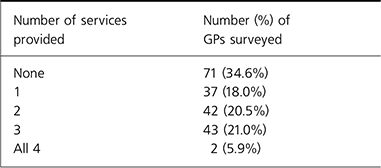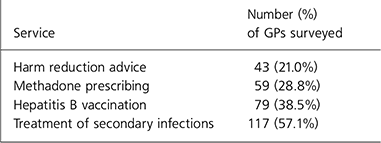Opiate misuse has become more prevalent in modern society. This has led to an increase in demand on the finite resources of specialist services and, consequently, unacceptable waiting lists. One suggested solution is for primary care to share the burden with specialist services. The Department of Health has provided guidelines regarding the clinical management of drug misuse and dependence (Department of Health, 1999), emphasising the increasing role of general practitioners (GPs). These guidelines are considered to be the benchmark for good clinical practice in this area (Stationery Office, 1998).
This initiative raises many questions. What is the current level of service provided by GPs? Have they received any training on aspects of drug misuse and what is their level of knowledge? How confident are they in managing patients who misuse opiates? Are they aware of the guidelines? Are they willing to change? What resources are required to achieve these expectations? At present, there is little information available to answer these questions. We carried out a large questionnaire study among GPs designed to explore these issues. Here, we report the level of current provisions, the discrepancy between this and the Department of Health expectations and resources required to bridge this gap.
Method
A questionnaire based on the Department of Health guidelines Drug Misuse and Dependence: Guidelines for Clinical Management (Department of Health, 1999) was designed to study the following among GPs:
-
1. Number of opiate misusers on their list.
-
2. Services currently being provided for opiate misusers. The services studied were those emphasised in the Department of Health guidelines:
-
(a) methadone prescribing;
-
(b) hepatitis B vaccination;
-
(c) harm reduction advice;
-
(d) treatment of secondary infections.
-
-
3. Their confidence in managing patients with opiate misuse.
-
4. Their views as to whether methadone should be prescribed for patients dependent on opiates.
-
5. The amount of training regarding the management of opiate misuse they had received as a medical student and in the previous 12 months.
-
6. Their perceptions as to which categories of patients who misuse opiates should be referred to specialist services rather than being treated in primary care.
-
7. Whether they had read the guidelines.
-
8. The impact of these guidelines on their practice.
-
9. Their opinions as to the resources required to provide the services studied. The resources studied were the shared care scheme, extra funding and extra training. These were ranked 1-3, with 1 being the most important.
-
10. Their opinions as to which components of a shared care scheme are most important. Components studied were training, supervision and advice. These were ranked 1-3, with 1 being the most important.
The questionnaire was distributed to all GPs in Solihull and Warwickshire (n=379). Data were analysed with the Chi-squared, Fisher's exact, Mann-Whitney U and Kruskal-Wallis tests, using the computer software SPSS version 10.
Results
Replies were received from 205 GPs. This represented 77.2% of GP practices. The number of patients dependent on opiates on their lists ranged from 0 to 20, with a mean of 2.68. The mean prevalence was 1.27 per 1000.
Services currently provided
The number of the studied services provided by GPs is shown in Table 1. The mean number of services provided was 1.45 (SD=1.31). The number of GPs providing each individual service is shown in Table 2. These services include:
Table 1. Levels of drug misuse service provided by general practitioners (GPs)

| Number of services provided | Number (%) of GPs surveyed |
|---|---|
| None | 71 (34.6%) |
| 1 | 37 (18.0%) |
| 2 | 42 (20.5%) |
| 3 | 43 (21.0%) |
| All 4 | 2 (5.9%) |
Table 2. Frequency of general practitioners (GPs) providing each of the services studied

| Service | Number (%) of GPs surveyed |
|---|---|
| Harm reduction advice | 43 (21.0%) |
| Methadone prescribing | 59 (28.8%) |
| Hepatitis B vaccination | 79 (38.5%) |
| Treatment of secondary infections | 117 (57.1%) |
Methadone prescribing
GPs were significantly more likely to prescribe methadone if they had more opiate misusers on their personal list (Spearman's correlation coefficient=0.227, P=0.003), were more confident in managing opiate addicts (χ2=13.681, df=1, 2-sided P<0.001, Fisher's exact test <0.001), had a positive attitude to the prescribing of methadone (χ2=13.755, df=1, 2-sided P<0.001, Fisher's exact test <0.001), had received training in the past 12 months (χ2=5.038, df=1, 2-sided P=0.025, Fisher's exact test=0.044), were also offering hepatitis B vaccine to opiate addicts (Spearman's correlation coefficient=0.338, P<0.001) or treating secondary infections in addicts (Spearman's correlation coefficient=0.290, P<0.001). The likelihood of GPs prescribing methadone was not influenced by training in addiction as a medical student.
Hepatitis B vaccination
GPs were significantly more likely to offer hepatitis B vaccination if they had more patients dependent on opiates on their list (Spearman's correlation coefficient=0.197, P=0.011) or were more confident in managing opiate addicts (χ2=15.616, df=1, 2-sided P<0.001, Fisher's exact Test <0.001). Attitudes to methadone prescribing, or training, either as a medical student or in the past 12 months, did not influence whether or not hepatitis B vaccination was offered.
Harm reduction
GPs were significantly more likely to offer harm reduction if they had more opiate users on their list (Spearman's correlation coefficient=0.153, P=0.048) or if they were more confident in managing opiate addicts (χ2=7.980, df=1, 2-sided P=0.005, Fisher's exact test=0.008). Attitudes to methadone prescribing or training, either as a medical student or in the past 12 months, did not influence whether or not harm reduction was offered.
Treatment of secondary infections
GPs were more likely to treat secondary infections if they had more patients using opiates on their list (Spearman's correlation coefficient=0.468, P<0.001) or if they were more confident in managing opiate addicts (χ2=8.632, df=1, 2-sided P=0.003, Fisher's exact test=0.004). Attitudes to methadone prescribing or training, either as a medical student or in the past 12 months, did not influence whether or not treatment of secondary infections was offered.
Referral to secondary care
Sixty-seven per cent of GPs would refer even non-dependent users of opiates to secondary care and 90.9% would refer all of those who are dependent on opiates. The remaining 9.1% of GPs would refer only those patients who misuse opiates with a chaotic lifestyle, forensic history, or comorbid mental or physical disorders.
Willingness to change
One hundred and six (51.7%) GPs had read the guidelines. Of these, only 12 (11.5%) planned to change their practice within existing resources, 41 (39.4%) were prepared to change their practice, but only with additional resources, and 51 (49%) were not willing to change their practice, even with additional resources. Willingness to change was significantly associated with having more patients who misuse opiates on their list (Spearman's correlation coefficient=0.241, P=0.026), as was already providing more services (Spearman's correlation coefficient=0.234, P=0.017). Training, either as a student or in the past 12 months, did not influence whether or not the GP would read the guidelines or be prepared to follow them.
Resources required to improve services
The mean ranks for the shared care scheme, additional training and additional funding were 1.87, 1.98 and 2.15, respectively. The GPs considered shared care and additional training to be equally important, and additional funding as being least important. The mean rank for additional funding was significantly different to that for either training or shared care (Mann–Whitney U=10282, Wilcoxon W=22372, Z=–2.252, P=0.024 and Mann–Whitney U=9520.5, Wilcoxon W=21610.5, Z=–3.237, P=0.001, respectively).
GPs who already prescribed methadone (Spearman's correlation coefficient=0.178, P=0.027), were confident in managing opiate addicts (Spearman's correlation coefficient=–0.188, P=0.021) or had the greatest amount of training in the past 12 months (Spearman's correlation coefficient=–0.876, P=0.002) were less likely to want training. Those who prescribed methadone were more likely to want a shared care scheme (Spearman's correlation coefficient=–0.168, P=0.037).
What GPs want from shared care
The mean ranks for training, advice and supervision were 1.799, 2.087 and 2.107, respectively. Training was considered to be significantly more important than either advice or supervision (Mann-Whitney U=17779.5, Wilcoxon W=38689.5, Z=–2.68, P=0.007 and Mann-Whitney U=17605.5, Wilcoxon W=38515.5, Z=–2.834, P=0.005, respectively).
Discussion
Opiate misuse can lead to irreversible consequences for the individual, their family and society. Appropriate therapeutic interventions such as those recommended in the Government guidelines (Department of Health, 1998) limit this damage. Therefore, it was disappointing to find that less than 6% of the GPs provided all four of the services studied and that a third of them provided none of these essential services. This is perhaps unsurprising as many GPs have a negative attitude towards those who misuse drugs, considering that they are unrewarding to treat, pose management problems and take up a lot of time (Reference Deehan, Taylor and StrangDeehan et al, 1997).
The likelihood of services being provided was significantly correlated with the number of patients who misuse opiates on the GP's personal list. This might be because these service users tend to register with GPs who are known to cater for them. Furthermore, it could also be that GPs who are not particularly interested in treating patients who misuse opiates may well under-diagnose them. It is not surprising to find that confidence in managing such patients was significantly associated with service provision. It was remarkable, however, that training as a medical student had no impact on the likelihood of providing these services. This might be because such training was insufficient. Glass (Reference Glass1989) found that undergraduate training in substance misuse in British medical schools was inadequate. Training in the past 12 months only had a positive impact on the provision of methadone prescribing. It had no impact on the provision of the other services studied or on the overall number of services provided.
It was interesting to note that there was a large variation in the provision of each of the services. Treatment of infections and hepatitis B vaccination were the most commonly provided services. Less than a third of GPs prescribed methadone and less than a quarter offered harm reduction advice. This is to be expected, as GPs are confident in treating infections and with providing vaccinations, whereas the prescribing of methadone and provision of harm reduction advice are more specialised interventions. It is therefore important to look at ways to increase GPs’ confidence in these interventions.
Department of Health guidelines recommend that only complicated cases of opiate dependence should be referred to secondary care. Such cases include those patients with comorbid physical or mental disorders, a serious forensic history, polydrug use or a history of frequent relapses. However, almost 90% of our respondents referred all patients dependent on opiates, and this referral pattern might indicate an unwillingness to work with those who misuse opiates. Many GPs do not consider primary care to be an appropriate setting for working with such individuals (Reference Deehan, Taylor and StrangDeehan et al, 1997).
There is a huge gulf between the government expectations and current practice with regard to the management of those who use opiates in primary care. It is important that this gap be narrowed if care is to be improved. This will be a difficult task, as only a small proportion of GPs have even read the guidelines and of these, only half are willing to change their practice. It may well be that the government expectations are unrealistic. If one wishes to increase the involvement of GPs in this area, then scarce resources should be targeted towards shared care and training.
Declaration of interest
None.
Acknowledgement
We would like to thank Glenys Hemming for help in distributing the questionnaires.





eLetters
No eLetters have been published for this article.